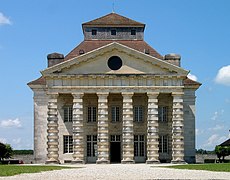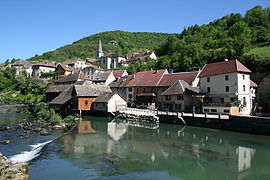Doubs
Doubs | |
|---|---|
 Prefecture building of the Doubs department, in Besançon | |
 Doubs in France | |
| Coordinates: 47°10′N 06°25′E / 47.167°N 6.417°E | |
| Country | France |
| Region | Bourgogne-Franche-Comté |
| Département | 4 March 1790 |
| Prefecture | Besançon |
| Subprefectures | Montbéliard, Pontarlier |
| Government | |
| • President | Christine Bouquin[1] |
| Area | |
| • Total | 5,232.6 km2 (2,020.3 sq mi) |
| Population (2014)[3] | |
| • Total | 534,710 |
| • Density | 100/km2 (260/sq mi) |
| Demonym | Doubistes |
| Time zone | UTC+1 (CET) |
| • Summer (DST) | UTC+2 (CEST) |
| ISO 3166 code | FR-25 |
| Arrondissements | 3 |
| Cantons | 19 |
| Communes | 578 |
| Website | www.doubs.fr |
Doubs is a department in eastern France. It is in the Bourgogne-Franche-Comté region. It is named after the Doubs river.
The largest city in the department, and its prefecture (capital), is the city of Besançon.
History
[change | change source]Doubs is one of the original 83 departments created during the French Revolution on 4 March 1790 with Besançon as its capital.[4] It was formed from part of the old province of Franche-Comté.
It was divided in six districts: Besançon, Baume-les-Dames, Saint-Hippolyte, Pontarlier, Quingey and Ornans. In 1800, with the creation of the arrondissements in France, the six districts were changed into four arrondissements: Besançon, Baume-les-Dames, Pontarlier and Saint-Hippolyte. In 1816, the subprefecture of Saint-Hippolyte is moved to Montbéliard.[4]
After the Battle of Waterloo (18 June 1815), the department was occupied by the Austrian army from June 1815 to November 1818.
On 10 September 1926, the arrondissement of Baume-les-Dames was eliminated.[4]
Geography
[change | change source]Doubs is part of the Bourgogne-Franche-Comté region. It has an area of 5,232.6 km2 (2,020 sq mi).[2]
The department borders with 3 departments of the Bourgogne-Franche-Comté region (Jura, Haute-Saône and Territoire de Belfort) and 3 cantons of Switzerland (Vaud, Neuchâtel and Jura).
The Doubs department is partially on the Jura Mountains, mainly the eastern part of the department on the border with Switzerland. The highest point in the department is Mont d'Or (46°44′0″N 6°21′24″E / 46.73333°N 6.35667°E), 1,461 m (4,793 ft) high;[5] it is on the border between the communes Jougne and Longevilles-Mont-d'Or at about 20 km (12 mi) to the south of the city of Pontarlier. The lowest point is where the Ognon leaves the department, 200 m (660 ft) high.
The main rivers in the department are the Doubs, that gives its name to the department, the Ognon and the Loue (tributary of the Doubs).
Climate
[change | change source]The Köppen climate classification type for the climate at Besançon is an "Oceanic climate" (also known as Marine West Coast Climate) and of the subtype Cfb.[6]
The average temperature for the year in Besançon is 11 °C (52 °F). The warmest month, on average, is July with an average temperature of 19.9 °C (67.8 °F). The coolest month, on average is January, with an average temperature of 2.3 °C (36.1 °F).
The average amount of precipitation for the year in Besançon is 934.7 mm (36.80 in). The month with the most precipitation on average is September with 106.7 mm (4.20 in) of precipitation. The month with the least precipitation on average is February with an average of 50.8 mm (2.00 in).[6]
Administration
[change | change source]Doubs is managed by the Departmental Council of Doubs in Besançon. The department is part of the Bourgogne-Franche-Comté region.
Administrative divisions
[change | change source]There are 3 arrondissements (districts), 19 cantons and 578 communes (municipalities) in Saône-et-Loire.[7]
| INSEE code |
Arrondissement | Capital | Population[8] (2014) |
Area[9] (km²) |
Density (Inh./km²) |
Communes |
|---|---|---|---|---|---|---|
| 251 | Besançon | Besançon | 248,199 | 1,942.2 | 127.8 | 260 |
| 252 | Montbéliard | Montbéliard | 176,670 | 1,255.7 | 140.7 | 169 |
| 253 | Pontarlier | Pontarlier | 109,841 | 2,034.7 | 54.0 | 149 |
The following is a list of the 19 cantons of the Doubs department (with their INSEE codes), following the French canton reorganisation which came into effect in March 2015:[10]
- Audincourt (2501)
- Baume-les-Dames (2502)
- Bavans (2503)
- Besançon-1 (2504)
- Besançon-2 (2505)
- Besançon-3 (2506)
- Besançon-4 (2507)
- Besançon-5 (2508)
- Besançon-6 (2509)
- Bethoncourt (2510)
- Frasne (2511)
- Maîche (2512)
- Montbéliard (2513)
- Morteau (2514)
- Ornans (2515)
- Pontarlier (2516)
- Saint-Vit (2517)
- Valdahon (2518)
- Valentigney (2519)
Demographics
[change | change source]The inhabitants of Doubs are known, in French, as Doubistes, or Doubiens (women: Doubiennes).[11]
Doubs had a population, in 2014, of 534,710,[3] for a population density of 102.2 inhabitants/km2. The arrondissement of Besançon, with 248,199 inhabitants, is the arrondissement with more inhabitants.[8]
Evolution of the population in Doubs

The cities with more than inhabitants in the department are:[8]
| City | Population[8] (2014) |
Arrondissement |
|---|---|---|
| Besançon | 116,690 | Besançon |
| Montbéliard | 25,521 | Montbéliard |
| Pontarlier | 17,413 | Pontarlier |
| Audincourt | 14,131 | Montbéliard |
| Valentigney | 9,970 | Montbéliard |
| Morteau | 6,827 | Pontarlier |
| Seloncourt | 5,906 | Montbéliard |
| Bethoncourt | 5,729 | Montbéliard |
| Grand-Charmont | 5,535 | Montbéliard |
| Valdahon | 5,344 | Pontarlier |
Places of interest
[change | change source]Some places of interest are:
- The Citadel of Besançon.
- The Royal Saltworks at Arc-et-Senans.
- The castle of Montbéliard.
- The Fort de Joux.
- The village of Lods.
Gallery
[change | change source]-
Royal Saltworks at Arc-et-Senans.
-
Fort de Joux.
-
Lods, one of the most beautiful villages of France.
-
The Doubs river is the main river of the department.
Related pages
[change | change source]References
[change | change source]- ↑ "Les élus" (in French). Département du Doubs. Archived from the original on 23 September 2017. Retrieved 27 June 2017.
- ↑ 2.0 2.1 "Département du Doubs (25)". Comparateur de territoire (in French). Institut national de la statistique et des études économiques - INSEE. Retrieved 27 June 2017.
- ↑ 3.0 3.1 "Populations légales 2014: Recensement de la population - Régions, départements, arrondissements, cantons et communes" (in French). Institut national de la statistique et des études économiques - INSEE. Retrieved 21 June 2017.
- ↑ 4.0 4.1 4.2 "Historique du Doubs". Le SPLAF (in French). Retrieved 28 June 2017.
- ↑ "Mont d'Or, France". Peakbagger.com. Retrieved 17 August 2017.
- ↑ 6.0 6.1 "Besançon, France - Climate Summary". Weatherbase. Retrieved 28 June 2017.
- ↑ "Département du Doubs (25)". Géographie administrative et d'étude (in French). Institut national de la statistique et des études économiques - INSEE. Retrieved 28 June 2017.
- ↑ 8.0 8.1 8.2 8.3 "Régions, départements, arrondissements, cantons et communes" (PDF). Populations légales 2014 (in French). Institut national de la statistique et des études économiques - INSEE. Retrieved 28 June 2017.
- ↑ "Département du Doubs (25)". Comparateur de territoire (in French). Institut national de la statistique et des études économiques - INSEE. Retrieved 28 June 2017.
- ↑ "Décret n° 2014-240 du 25 février 2014 portant délimitation des cantons dans le département du Doubs" (in French). Legifrance.gouv.fr. 25 February 2014. Retrieved 28 June 2017.
- ↑ "Doubs (25)" (in French). habitants.fr. Retrieved 28 June 2017.
Other websites
[change | change source]- Departmental Council website Archived 2014-05-03 at the Wayback Machine (in French)
- Prefecture website (in French)
- Doubs Tourisme (in French)








